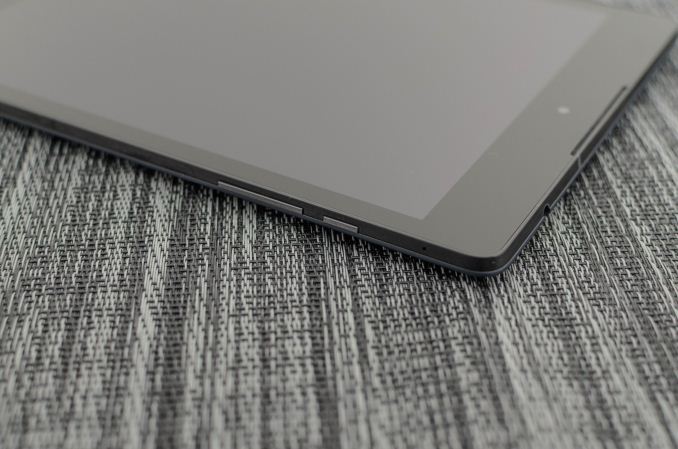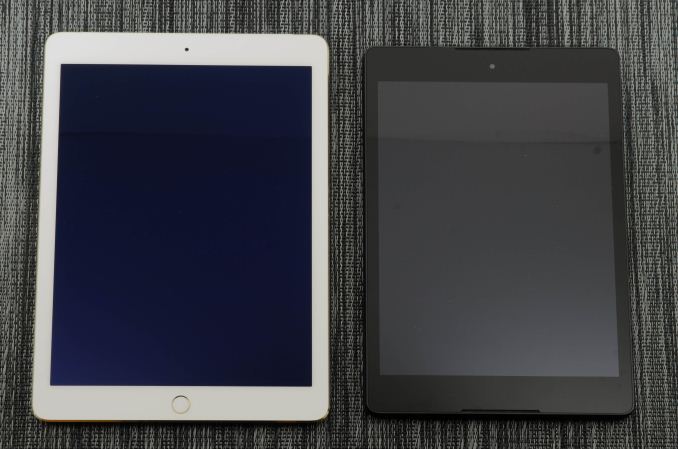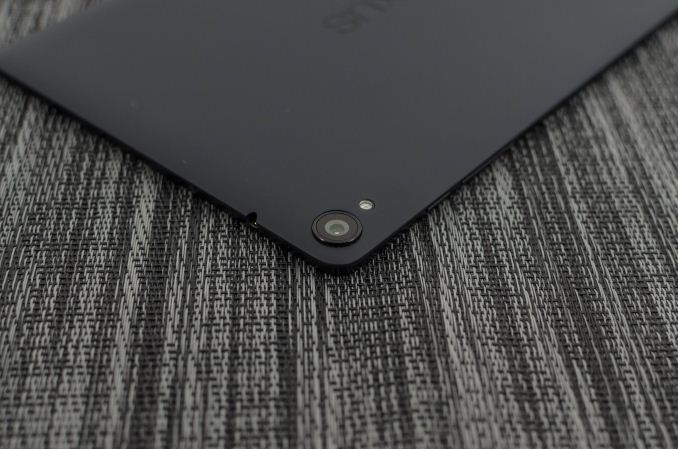The Google Nexus 9 Review
by Joshua Ho & Ryan Smith on February 4, 2015 8:00 AM EST- Posted in
- Tablets
- HTC
- Project Denver
- Android
- Mobile
- NVIDIA
- Nexus 9
- Lollipop
- Android 5.0
Final Words
The Nexus 9 is undoubtedly an aspirational device. For a long time now, Google and the Android tablet market in general have been in a position similar to Amazon’s Fire tablet. This has meant that the margin on the hardware itself has been quite low, and while quality was possible to achieve there were often sacrifices made in order to reach the targeted price point. This was seen in the form of lower CPU and GPU bins in the SoC, lower quality NAND, and generally poorer displays.
The Nexus 7 (2013) did manage to mostly avoid these issues, but Google had set the bar for price and performance to the point where OEMs would have issues with maintaining acceptable profit margins on a device. The Nexus 9 changes this strategy by reaching for a higher price point and attempting to deliver a no-compromise tablet in return. To figure out whether Google has succeeded, it’s worth going over each aspect of the device before coming to any sort of judgment.
The first and quite possibly most important aspect of the Nexus 9 is the SoC. To this end, the Nexus 9 is the very first Android device with AArch64 support enabled in Android. NVIDIA’s Tegra K1 with Denver is effectively the state of the art when it comes to SoCs in the Android OEM space, and no other device has launched with this SoC. While the fact that the SoC is built around the ARMv8 ISA is important, the architecture of the CPU itself is easily one of the most interesting designs we’ve seen in years. Unfortunately, while the design of the CPU is academically interesting it doesn’t seem that this produces real-world benefits. The Nexus 9 has one of the fastest SoCs we’ve seen to date, but this comes at the cost of worse power efficiency than the Cortex A15 version of the Tegra K1.
Another piece of the puzzle is the design, which is one of the key differentiators for a high-end mobile device. While one can debate the merits of various materials, it seems to be clear that an all-metal unibody chassis would’ve greatly improved the design of the Nexus 9 and justified its positioning better. While there is some level of give in the back cover, the buttons are quite thin and hard to find, and there’s a noticeable seam where the back cover and metal frame meet, the design isn’t actually all that bad in practice. Unfortunately, this seems to be a bit of a sore point as well for the Nexus 9 when compared against the iPad lineup.
While the SoC and design are often points of distinction for a premium tablet, the display is critical for any tablet. In this regard, the Nexus 9 does surprisingly well. With a 4:3 aspect ratio, high resolution, and high quality color calibration HTC and Google have outfitted the Nexus 9 with a great display. Unfortunately, there’s a great deal of variability present in these displays that presents itself in the form of backlight bleed along the edges of the display. While my unit only has a slight amount of bleed along the top edge of the device, other units can have more or less backlight bleed depending upon variance in production.
The one aspect that seems to be the product of a poor design choice is the high reflectivity of the display. Although I’m reasonably sure that the display is laminated due to the lack of an obvious gap between the display and glass, it seems that the optical material between the display and glass is poorly designed as I can see a distracting double reflection in the display. The Nexus 9 also compares unfavorably to the iPad Air 2 in this case as the anti-reflective coating on the iPad Air 2 is far superior to just about anything I’ve seen on the market.
Although I previously noted that the power efficiency of the SoC isn’t up to scratch, overall battery life is quite good on the Nexus 9. With a combination of a large battery and efficient display, Google and HTC have managed to compensate for the power consumption issues that come with Denver’s performance. Unfortunately, it seems that Kepler’s desktop-first design results in worse power efficiency than what we see on competing solutions such as the “GXA6850” found in competing SoCs. Even if this is compensated for by the ability to enable desktop-class gaming, the Nexus 9 doesn’t appear to support full OpenGL to begin with, unlike the SHIELD Tablet. This means that the extra capabilities enabled by the GPU are effectively wasted, which hurts the value proposition for the device overall. In light of the launch of the Tegra X1, I can't help but wonder how different the experience of the Nexus 9 would be with NVIDIA's latest SoC.
Outside of these primary elements of the tablet, there seems to be a reasonable level of attention to detail. The camera is acceptable, even if the focus and capture latency aren’t the greatest. The audio quality from the speakers is also quite good, and really helps to enable a great experience when watching any kind of video or listening to music without earbuds/headphones. The software experience is acceptable, although Google continues to fight issues with ecosystem support for tablets.
With all of this in mind, it’s hard to give a resounding recommendation of the Nexus 9. The Nexus 9 is a step towards a high-end Android tablet, but not the leap that Google was hoping for. If you want an Android tablet near the size of the Nexus 9, I can’t really recommend anything else. The Galaxy Tab S falls short on account of performance and battery life, and despite the somewhat unremarkable design of the Nexus 9 I believe that it is nicer than the Galaxy Tab S. However, if one were to assume that OEMs are currently readying devices to truly carry the torch of the high-end tablet, the Nexus 9 is a hard sell. I suspect that this wouldn’t be nearly as difficult if the Nexus 9 had a lower price point of $300 and $350 USD for the 16GB and 32 GB WiFi variants, and $450-$500 for the 32GB LTE variant. Google has managed to get close to the mark with the Nexus 9, but like the Nexus 6 it seems that it’s up to the OEMs to cover the remaining distance.














169 Comments
View All Comments
AbRASiON - Thursday, February 5, 2015 - link
LCD, not OLED? Blacks being grey? Nope :/blzd - Friday, February 6, 2015 - link
I'd actually rather grey blacks then the loss of detail in black areas. Pure black is nice, but not when it comes at the expense of shadow details.techn0mage - Thursday, February 5, 2015 - link
I agree that late is better than never. Rather than discuss things that can't be changed, I felt the following points were worth raising:Is there any Nexus 6 data in the benchmark charts? I didn't see any. The N6 and N9 were released roughly around the same point in time, and like the N5 and N7 they are high-profile devices in the Android landscape, so it would have been nice to have them in the charts to make comparisons. Please correct me if I've overlooked anything.
The Denver deep dive, while certainly relevant to Nexus 9 and good AT content on any day, was probably a good candidate for having its own article. I believe it is fair to say the Denver content is -less- time sensitive than the overall review. Hopefully the review was not held back by the decision to include the "DDD" content - and to be clear right now I have no reason to believe it was.
WndlB - Thursday, February 5, 2015 - link
Particularly in this kind of full-dress review of high-end devices, could you start covering the delivered sound, the DAC chips and headphone jack?Via A-B comparisons, I'm finding some real differences and, as people go to more high-quuality audiio streams (plus video sound), this is becoming a differentiator of significance. Thanks.
JoshHo - Tuesday, February 10, 2015 - link
We could do subjective opinion, but properly testing 3.5mm output requires significant investment in test equipment.name99 - Thursday, February 5, 2015 - link
I know this isn't exactly a Nexus9 questions, but how can your battery life results for iPad Air2 be so inconsistent?We are given 10.18 hrs for "display a white image" and 13.63 hrs for "display video". For an OLED display this is possible, but not for a LED-backlit display unless you are running the video at a "base-level" brightness of much lower than the 200 nits of the "display a white image", and what's the point of that? Surely the relevance of the "display a white image" is to show how long the display+battery lasts under normal usage conditions, not when being used as a flashlight?
My point is --- I am guessing that the "display a white image" test utilizes some app that prevents the screen from going black. Do you have confidence that that app (and in particular whatever tickling of the OS that is done to prevent sleep) is doing this in the energy optimal way, on both iOS and Android?
JoshHo - Tuesday, February 10, 2015 - link
I don't believe there was any real background CPU usage. To my knowledge the difference is that Apple enables dynamic contrast in movies.easp - Thursday, February 5, 2015 - link
"The successor to the Nexus 7 was even more incredible, as it pushed hardware that was equal to or better than most tablets on the market at a lower price. However, as with most of these low cost Nexus devices not everything was perfect as corners still had to be cut in order to hit these low price points."So, hardware that was equal or better, except it wasn't? This is a situation where being more specific would help. My guess, when you said equal or better you were referring to certain specifications, certain obvious specifications like core count, RAM, and maybe screen resolution?
mkygod - Friday, February 6, 2015 - link
Owned a Nexus 9 for almost 3 months. I purchased three actually to see if backlight bleed was any better, but nope; so I ended up returning them a couple weeks ago. The bleeding was pretty bad; worse than any LCD device i've ever used and definitely worse than the Nexus 5 and Nexus 7. And it would've been okay if it had uniform bleeding like the Nexus 5, but it had blotches of bright spots all along the edges which is even more distracting. I found the reflectivity with the screen a non-factor in my exclusively indoor use. It's a shame because the Nexus 9 is an otherwise damn good tablet. What's also disappointing, as the review points out, is if you want a high-end tablet around this size, your only options are the 9 and the Tab S. It seems like a lot of really good Android tablets are in the 8" size, such as the Shield and new Dell Venue, with more manufacturers on the horizon making tablets in this size.MartinT - Friday, February 6, 2015 - link
I wonder what level of load penalty is incurred by having to ship in optimized code from main memory. Is there any prefetching going on to preposition code segments in lower level caches ahead of being called?